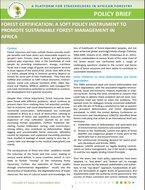Context
Forest resources and trees outside forests provide multiple benefits and have direct and measurable impacts on peoples lives. Forests, trees on farms, and agroforestry systems play important roles in the livelihoods of rural people by providing employment, energy, nutritious foods and a wide range of goods and ecosystem services in most regions of the world (FAO, 2014). Over 90% of the 1.2 billion people living in extreme poverty depend on forests for some part of their livelihoods. They have also fulfilled and continue to fulfil critical economic, environmental, social and cultural functions (FAO, 2003; Barklund and Teketay, 2004).In addition, well managed forests have tremendous potential to contribute to sustainable development and a greener economy.
Despite their critical importance, forest resources have been faced with different problems, which continue to prevent them from realizing their full potential contribution to economic and social development as well as environmental conservation. Deforestation has continued unabated in Africa as a result of destruction, clearing or incineration of forest and woodland resources for the expansion of crop cultivation spurred by an ever-increasing human population. Further, fuelwood harvesting, human settlement, mining, road construction, among others, also contribute to deforestation. Illegal logging and unsustainable forest resources utilization caused by improper and unplanned harvesting practices have resulted in wastage of wood, owing to very low recovery rates and damage to the residual trees/plants and stands.
The consequences of these and other problems include the reduction of the forest and tree cover, leading to serious wood deficits in some countries (which in turn leads to further mining of the remaining forest resources). Further, the reduction of forest quality through environmental degradation results into the decline/loss of biodiversity, the degradation/loss of water resources, the loss of cultural assets and knowledge, the loss of livelihoods of forest-dependent peoples, and not least enhanced global warming/climate change (Teketay, 2004-2005; Kowero et al., 2009; Chidumayo et al., 2011). Hence, stakeholders at various levels of the value chain of the forest sector are confronted with a range of challenging questions related to the current and future state of forest resources and their ability to contribute to sustainable development.

